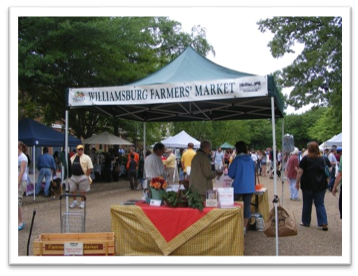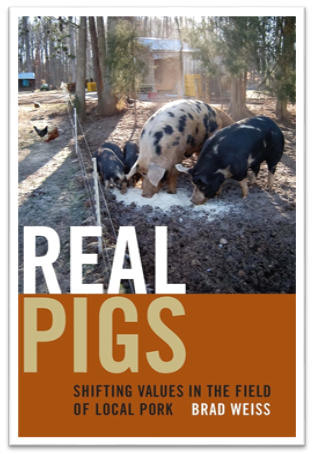By Kieran Loftis
Expectations vs what reality?

When we go to farmers markets, what do we expect? We expect local products – we want the food from farmers markets to be grown/produced nearby, as it makes us feel as if we are being more sustainable by purchasing produce and other goods that take much less travel time to reach us than produce from grocery stores. We expect sustainable products – we believe that local farmers must be sustainable because they are local. We expect cruelty-free products – we assume that the working conditions, worker treatment, and wages are much fairer and more equitable than those at large scale farms. But why do we make these assumptions?

I conducted a study at the Williamsburg farmers marketii, which meets every Saturday from 8 am – 12 pm in Colonial Williamsburg – a tourist attraction that also happens to be located next to the College of William and Mary. I visited the market multiple times over multiple weekends and studied the people, practices, and language portrayed there in hopes of exploring the truth about the locality of farmers markets.
(Mis)conceptions
The goal of farmers markets is to “provide opportunities for small farmers and businesses to sell their products” in order to satiate the increasing desire for “local” foodsiii. And this is exactly why we make the effort to go out of our way to attend nearby farmers markets even if they are at inconvenient hours and have elevated prices. We do this because we believe that the products from there come from local farms where the practices are sustainable, and the working conditions are great. We believe that buying from farmers markets promotes sustainability and fairness and contributes to local farms, but what are local farms?

During my research at the farmers market,iv I walked through the market and read the signs stating where the vendors came from along with a brief description of their products. Some farms were based 1 mile away, some were based 151 miles away – yet we both view these as local farms. At what point does a farm not become local anymore? Does it lose locality when it reaches a certain distance, or does it lose locality when it fails to meet the standards we set for them?
I believe that, for the Williamsburg farmers market, at least, they value the practices much more than locality; they seem to prefer smaller farms that are farther away rather than the larger scale industrial farms that are equidistant if not even closer. One of the most interesting things that I noted in my research, however, was that on most of the signs in the market, it stated that the farms were “animal cruelty-free“, or “involved no testing on animals,” or “sustainable, vegan products.” Not once did anyone mention the working conditions on the farm or who the actual farmers were. It seemed that people cared more about the treatment of the animals more than the treatment of the workers, or at least, they made the assumption that the workers were being treated well at these local farms, while they had to be told that the animals were being treated well.

In William and Mary Anthropology Professor Brad Weiss’ Real Pigs,v he examines the increasing demand for pork from the “alternative pig farms” in North Carolina rather than from industrial scale pig farms. To add on to that, he mentions how when discussing their practices, the farmers “rarely refer to the problems of racial disparities that are rife in North Carolina’s agricultural production or express concern for the condition of workers on local farms”, as instead they only seem to be interested in the “animal[s’] welfare.” (Weiss 61) When we strive for one thing, it is easy to lose sight of another. This statement stands true in the search for more sustainable agriculture – people are so worried about the treatment of the animals and the sustainability of the farmers’ practices that they tend to forget about the other problems that might be occurring at these locations, such as the treatment of the farmers themselves.
Scale Matters

Fresh Fruit, Broken Bodiesvi, by Berkley Medical Anthropology Professor Seth Holmes, discusses the working conditions and treatment of farmhands in west coast farms, and how unfairly the farmers were treated depending on where they came from. The farmers consisted of Latino-Americans and Mexican immigrants from many different regions, ranging from Mixtecs to Mestizos to Oaxacans, each one being treated differently from the other. At this industrial scale strawberry farms, hundreds of workers were employed to go out into the fields and work for hours and hours on end in the mud or in the heat, covered in dirt and pesticides, all while having to deal with racist remarks from their supervisors and unfair treatment of the Oaxacan workers compared to the others, simply because of the assumptions that the supervisors made based on Oaxacan stereotypes – like how they were better working hunched over in the strawberry fields rather than picking apples because they were “lower to the ground.” (Holmes 15) Additionally, it is estimated that ”only 13 percent are served by the federal Migrant Health Program.” (Randallvii) It is evident that there is ”a need to change misguided perceptions about migrant workers and the conditions they can tolerate”, which has unfortunately been both partially ignored and also ”normalized in our society.” (Randall) This mistreatment of workers occurs at most industrial farms, because their goals are not to create sustainable and equitable products, but rather to create enormous quantities of cheap products in order to maximize their profits. This price difference is obvious, especially when comparing the prices of products from the Williamsburg farmers market to those at the nearby Food Lion, the largest grocery store chain in Virginia.
| Product | Farmers Market | Food Lion |
| Beets | $4 / pound | $2 / pound |
| Sweet peppers | $3.5 / pound | $5 / pound |
| Sweet potatoes | $3 / pound | $1 / pound |
| Eggs | $5 / dozen | $3 / dozen |
| Chicken Pot Pie | $10 for 1 (large) | $12 for 4 (small) |
| Pumpkins | $0.5 / pumpkin | $9 / pumpkin |
| Gourd | $0.25 / gourd | N/A |
| Celery | $3 / small bunch $5 / large bunch | $1.8 / small bunch |
| Tuscan kale | $4 / bunch | $1.4 / bunch |
| Salad mix bags | $5 / large bag | $3.2 / medium bag |
| Bottled wine | $1 / bottle | $12 / bottle (on average) |
| Bar soap | $5 / bar | $7 / 8 bars (Irish Spring) $5 / 2 bars (Dove) $3.4 / 4 bars (Dial) |
| Cabbage | $1 / pound | $1.2 / pound |
| Jar of raw honey | $15 / 16 oz $25 / 32 oz | $8 / 16 oz $14 / 32 oz |

As you can see here, the prices for essentially everything at Food Lionviii are cheaper than the same product at the farmer market. To combat this and make nutritious and more sustainable foods more accessible to everyone, many farmers markets – including the one I visited in Williamsburg – use the SNAPs programix which allow customers to purchase tokens that grant them bonus dollars that they can use at select vendors. Though this price difference is somewhat offset by the SNAPs program, purchasing produce from grocery stores is still cheaper than at most farmers markets, and is also likely easier in general due to the accessibility and widespread nature of Food Lion and other similar grocery stores. Despite this, we still see great attendance at the farmers markets. Why? It is easier and cheaper to go to grocery stores, so why take the extra time and money to go buy your produce from a farmers market?
Closing Up Shop
To answer my own question, it is because of our assumptions about farmers markets. When we buy things at farmers markets, we believe that we’re supporting small businesses without ever having any explicit knowledge of the scale of their operations. We believe that we’re supporting local farmers, even though we do have explicit knowledge as to where they came from – but, again, we don’t support “local” farmers, we support sustainable farmers who treat the Earth and the animals with care. We often disregard price for these factors because we hold sustainability and fairness above price, but we make these decisions based solely on those factors, and often forget to consider how the working conditions at these farms could be similar to those at industrial scale farms. This is the hidden truth of the farmers market; We are so caught up in the sustainability and fair treatment of animals that we forget about those who actually work to produce and deliver the food – the farmers themselves.
_________________________________________________________________________________________________________
[i] “Williamsburg Farmers Market.” GoWilliamsburg.com – Helping You Plan the Perfect Visit., 28 Apr. 2021, https://gowilliamsburg.com/business-listing/williamsburg-farmers-market/.
[ii] Vrtachnik, Allie. “Williamsburg Farmers Market: An Experiential Market.” Farmers Market Coalition, 27 Mar. 2017, https://farmersmarketcoalition.org/williamsburg-farmers-market-experiential-market/.
[iii] Alonzo, Anne L. “Farmers Markets as Community Centerpieces.” USDA, 21 Feb. 2017, https://www.usda.gov/media/blog/2013/08/05/farmers-markets-community-centerpieces#:~:text=Farmers%20markets%20provide%20opportunities%20for,demand%20for%20locally%20produced%20food.
[iv] “Down Home Va Filming at Williamsburg Farmers Market.” Mr Williamsburg – Revolutionary Ideas on Real Estate, 12 Aug. 2010, https://williamsburgsrealestate.com/2010/08/11/down-home-va-filming-at-williamsburg-farmers-market/.
[v] Weiss, Brad. Real Pigs: Shifting Values in the Field of Local Pork. Duke University Press, 2016.
[vi] Holmes, Seth M. Fresh Fruit, Broken Bodies Migrant Farmworkers in the United States. Univ. of California Press, 2014.
[vii] Randall, Rebecca. “Who’s Picking Your Produce?” The Seattle Globalist, 24 Feb. 2014, https://seattleglobalist.com/2014/02/24/farm-labors-treacherous-path-oaxaca-to-washington/21141.
[viii] “Food Lion in Williamsburg, VA Grocery Retailer. Groceries.” Food Lion in Williamsburg, VA Grocery Retailer. Groceries., https://stores.foodlion.com/va/williamsburg/1234-richmond-road.
[ix] “Snap.” Farmers Market Coalition, 17 Apr. 2019, https://farmersmarketcoalition.org/advocacy/snap/.

Leave a comment